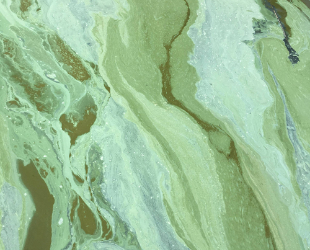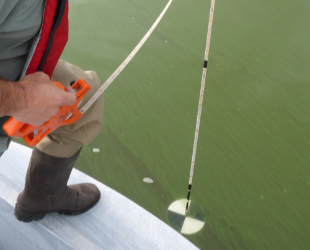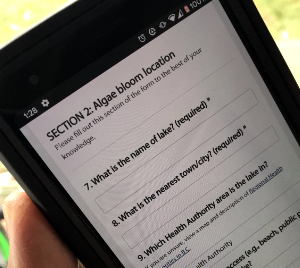What causes an algae bloom?
Algae are a natural part of all aquatic ecosystems, but prolific growth can cause a dense mass of algae (called a bloom) to form.
Algae blooms can occur when a combination of suitable environmental conditions exist for abundant algal growth (e.g., increased nutrients, warmer temperature, abundant light, and stable wind conditions). When these conditions are favorable for one species over another, it allows for one organism to become dominant and form a bloom.
Some human activities (such as agricultural run-off or poorly functioning septic systems) can make blooms more likely, and excessive amounts of nutrients within a lake can markedly increase the risk and severity of algal blooms. However, excessive nutrients may not lead to a bloom if other factors are unfavourable. For example, in a turbid shallow lake there may be insufficient light to support a bloom despite having high nutrient concentrations and warm water.

Cyanobloom on Chimney Lake, 2020 |

Cyanobloom on Ellison Lake, 2015 |
Environmental conditions contributing to algal blooms
There are many causes for algal blooms in freshwaters and it is often difficult to pinpoint specific reasons why a bloom forms. In many cases, a set of unique environmental conditions occur in a waterbody, which can lead to a particular species dominating and triggering a bloom.
While bloom formation is waterbody specific, the most common factors for bloom formation are timing, nutrients, temperature, light, and stable conditions.
![]()
Timing:
![]() Algal blooms in BC most often occur in the late-summer and early-fall. However, they can occur at any time of year, even under ice.
Algal blooms in BC most often occur in the late-summer and early-fall. However, they can occur at any time of year, even under ice.
Blooms typically last from several days to a few weeks, but can sometimes last as long as several months if environmental conditions are favourable.
Nutrients:
![]() Phosphorus and nitrogen are essential to algae production, and these nutrients encourage the growth of algae in waterbodies. Phosphorus is the key nutrient limiting algal growth in the majority of BC lakes. Increased concentrations of nutrients often lead to increased algal production, and increased risk of a bloom forming. This process of nutrient enrichment in a waterbody is called eutrophication, which can be exacerbated by anthropogenic influences such as:
Phosphorus and nitrogen are essential to algae production, and these nutrients encourage the growth of algae in waterbodies. Phosphorus is the key nutrient limiting algal growth in the majority of BC lakes. Increased concentrations of nutrients often lead to increased algal production, and increased risk of a bloom forming. This process of nutrient enrichment in a waterbody is called eutrophication, which can be exacerbated by anthropogenic influences such as:
- shoreline development
- certain farming practices
- wastewater and industry effluent
- or urban and stormwater runoff
Note that algae blooms can also occur in waterbodies where nutrients are fairly low, but are more common when nutrient concentrations, especially phosphorus, are high.
Temperature:
![]() Blooms usually develop during the warmer months of the year when water temperatures are higher. Cyanobacteria prefer warmer water and have a competitive advantage over other algae at temperatures over 25°C.
Blooms usually develop during the warmer months of the year when water temperatures are higher. Cyanobacteria prefer warmer water and have a competitive advantage over other algae at temperatures over 25°C.
In the spring when surface water begins to warm, many deeper lakes begin to thermally stratify (warm surface layer and colder bottom layer). As the warming progresses throughout the summer this temperature difference creates a density stratification in the water column. This creates a beneficial situation for algae and cyanobacteria to grow in a warm environment with increased light near the surface.
Light:
![]() Sufficient light is required for algae to grow and form high enough densities to bloom. The availability of light is largely influenced by the light penetration and mixing dynamics within the water body.
Sufficient light is required for algae to grow and form high enough densities to bloom. The availability of light is largely influenced by the light penetration and mixing dynamics within the water body.
- Euphotic Depth - The depth of water where enough light penetrates for algal growth. Defined as the depth where only 1% of surface light remains.
- Mixing Depth - The depth to which algae are mixed in a waterbody. This is either the depth of the waterbody when fully mixed, or is the depth of the thermocline (area of steep drop in temperature with depth) when a waterbody is thermally stratified.
- The ratio of the euphotic depth and mixing depth determines how much light is available for algae growth in a given waterbody. The greater the ratio, the more light is available for photosynthesis and algal growth.
Note that even in low light conditions, or in turbid water, cyanobacteria have higher growth rates than other algae. Many cyanobacteria can also regulate their buoyancy, enabling them to move to more favorable positions higher in the water column. These abilities to adapt to variable light conditions gives cyanobacteria a competitive advantage over other algal species.
Stable Conditions:
![]() Generally, calmer waters and low-wind conditions favour algal bloom development.
Generally, calmer waters and low-wind conditions favour algal bloom development.
Stable surface water conditions and less water column mixing promotes thermal stratification in waterbodies. Cyanobacteria prefer these stable water condition with minimal turbulence.
...previous topicWhat are Cyanobacteria (blue-green algae)? |
next topic... |
Image and icon references
Public domain and creative commons icons from the Noun Project
- Calendar by Fabio Rinaldi
- Clear sky by mynamepong
- Chemistry by Fabio Rinaldi
- Thermometer by jessie_vp
- Sun by Eugene Maksymchuk
- Oil spill by James Fenton
- Photo by Alice Design
All other images are from Ministry of Environment and Climate Change Strategy staff files.
In this section

Use our online Algae Watch Observation submission form to send us your algae bloom photos and description.
If you have concerns that are immediate and related to drinking and/or recreational water use, please contact your local health authority.
To report a spill or other contamination source, contact the Provincial Emergency Program spill reporting line at 1-800-663-3456.
To report an act of pollution, contact the RAPP (Report All Poachers and Polluters) Line at 1-877-952-RAPP (7277), or report a violation online.
